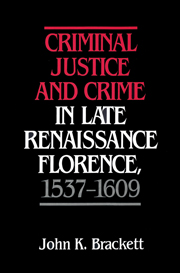Book contents
- Frontmatter
- Contents
- Acknowledgments
- Introduction
- 1 The bureaucratic structure of the Otto: the personnel and their functions
- 2 Financing the Otto
- 3 The Otto as police: organization and function
- 4 Criminal procedure before the Otto: from discovery to sentencing
- 5 The Otto and its role in the centralization of criminal justice in the Florentine state
- 6 Crime and criminals
- Conclusion
- Appendix 1 Names of other officers of the Otto di Guardia e Balìa, 1537–1609, as we have them
- Appendix 2 Budget totals by year
- Appendix 3 Comparison of detailed average expenditures for budgets, 1537–1547 and 1598–1609
- Appendix 4 Occupation key
- Bibliography
- Index
Conclusion
Published online by Cambridge University Press: 05 September 2009
- Frontmatter
- Contents
- Acknowledgments
- Introduction
- 1 The bureaucratic structure of the Otto: the personnel and their functions
- 2 Financing the Otto
- 3 The Otto as police: organization and function
- 4 Criminal procedure before the Otto: from discovery to sentencing
- 5 The Otto and its role in the centralization of criminal justice in the Florentine state
- 6 Crime and criminals
- Conclusion
- Appendix 1 Names of other officers of the Otto di Guardia e Balìa, 1537–1609, as we have them
- Appendix 2 Budget totals by year
- Appendix 3 Comparison of detailed average expenditures for budgets, 1537–1547 and 1598–1609
- Appendix 4 Occupation key
- Bibliography
- Index
Summary
The history of the Florentine Otto di Guardia e Balìa reflects the process of state formation in Renaissance and early modern Italy. Like other incipient state bureaucracies, the Otto began its existence as an ad hoc committee of powerful men deputized by their associates in the community to respond to an immediate problem. Because they proved useful beyond expectations, many such committees became permanent state agencies, often with ill defined and overlapping jurisdictions. No one present at the inception of the Otto would have predicted its continued existence over four hundred years; there were, after all, many other criminal courts already in operation. The modern mind views the resultant welter of temporary committees that became permanent with a mixture of amusement and befuddlement. What can these otherwise intelligent and responsible men have been thinking about to have let things get so out of hand?
With the birth of the communes, the tentacles of control by the emperor and the pope were thrown off by politically conservative men, who, having just escaped the suffocating clutches of the medieval state, had no desire to subject themselves to a different form of state control. It did not take long for them to realize, however, that their rebellious polities could not survive the violent challenges launched against them by their former masters without the benefit of some form of centralized political authority. The creation of temporary committees to address specific problems seemed an ideal means to arrive at a solution to their dilemma.
- Type
- Chapter
- Information
- Publisher: Cambridge University PressPrint publication year: 1992



